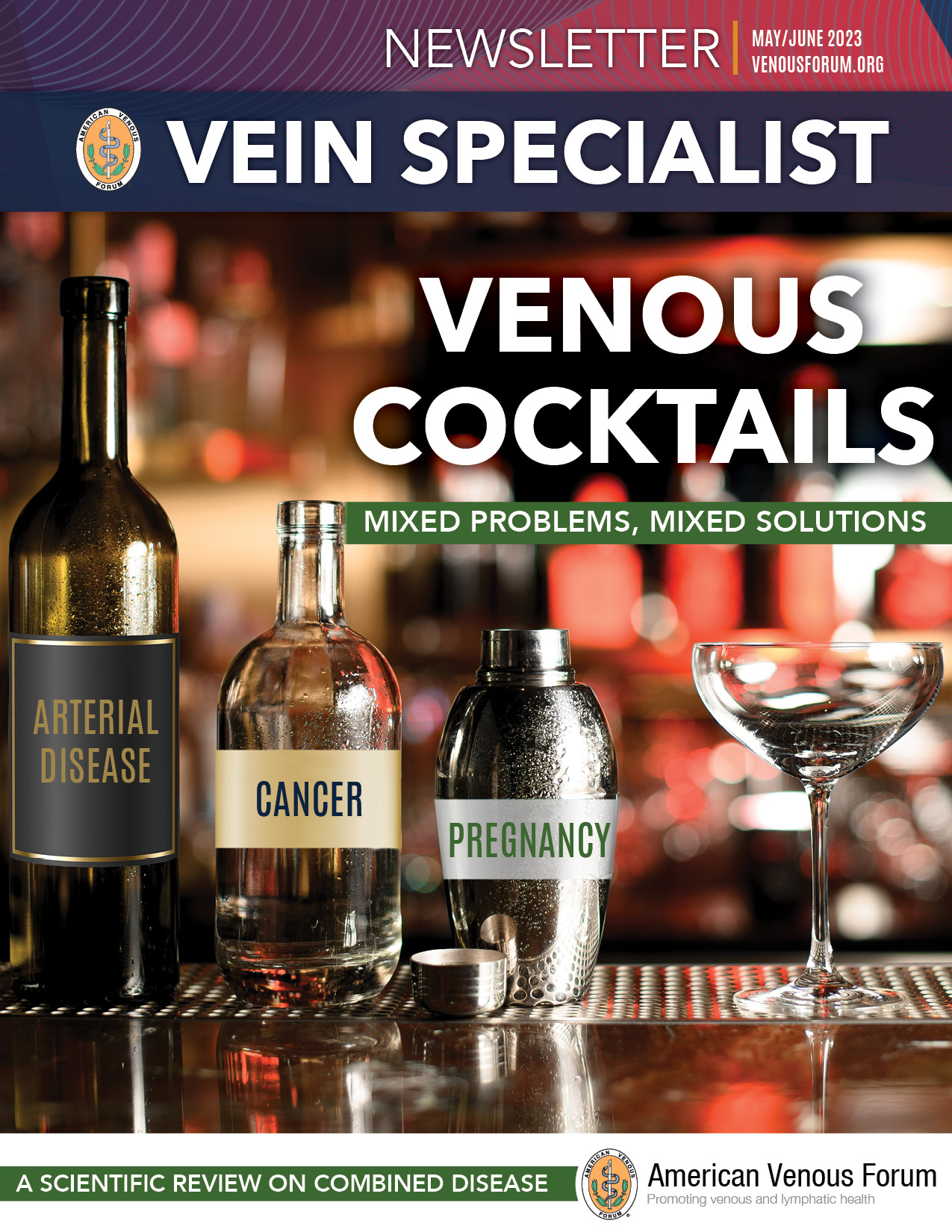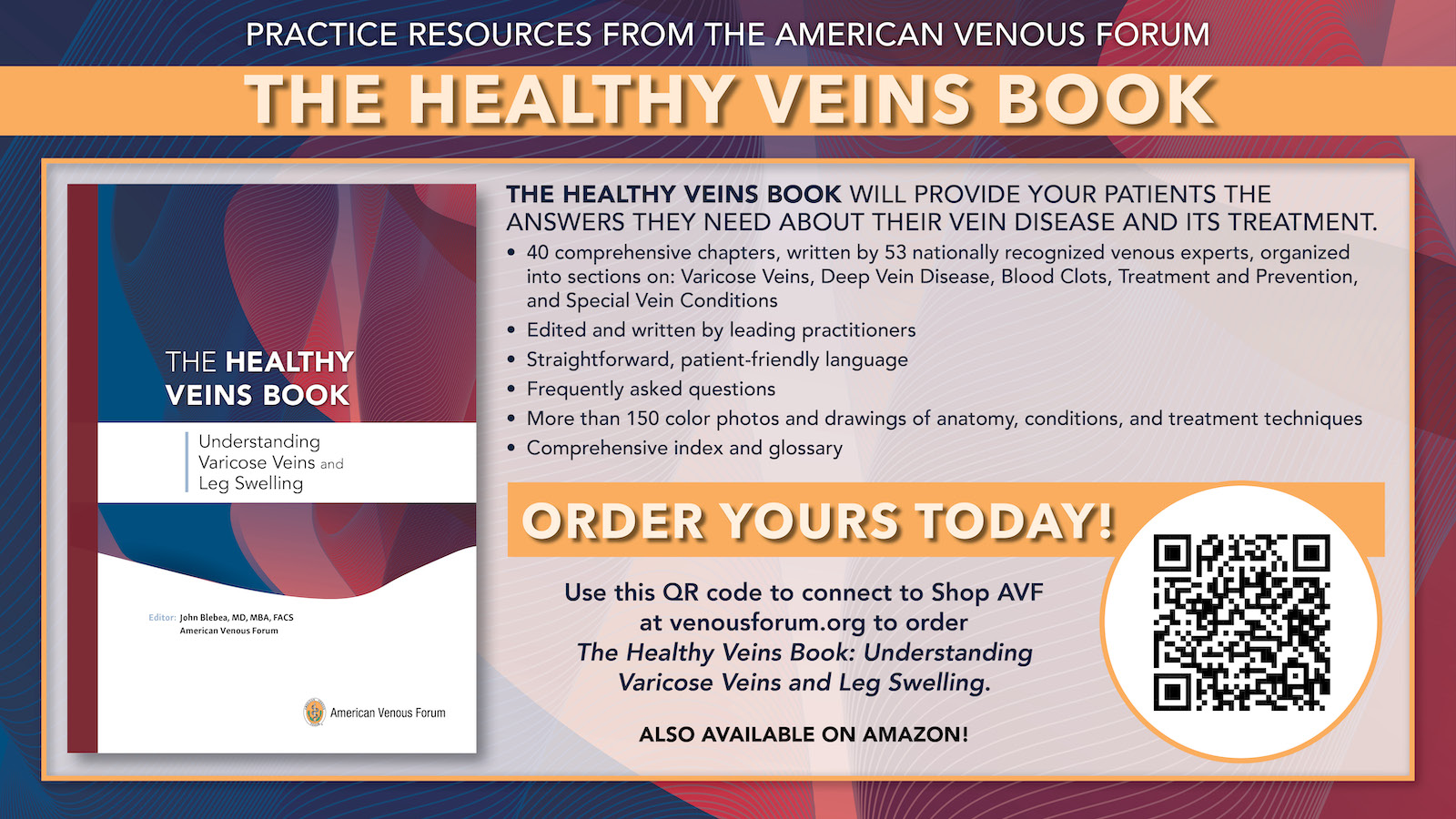
May / June Issue of Vein Specialist
The Queen is dead. Long live the King: How DOACs Replaced LMWHs in Cancer Thrombosis

Alfred Lee, MD, PhD
Professor of Medicine, Section of Hematology
Program Director, Hematology/Oncology Fellowship
Yale School of Medicine
New Haven, CT
Cancer and thrombosis have long been known to have an intimate association, dating back to the earliest descriptions of venous thrombosis in cancer by 19th century French physicians Jean-Baptiste Bouillard and Armand Trousseau. In population and registry studies, 20-30% of first-time cases of venous thromboembolism are associated with cancer. Up to a quarter of cancer patients may develop venous thromboembolism, and the risk of venous thromboembolism in the first 6 months after a diagnosis of cancer is 12-fold higher than in the general population. The development of thrombosis in cancer is universally regarded as an adverse prognostic sign.
The mechanisms underlying the hypercoagulability of malignancy are complex. Many cancer cells express tissue factor and release microvesicles containing tissue factor, which activates the coagulation cascade. Platelet activation is often increased in cancer, and thrombocytosis itself may be a risk factor for cancer-associated thrombosis. Endothelial cell activation and P-selectin expression by endothelial cells and by platelets in cancer recruit leukocytes, which mediate neutrophil extracellular trap formation, with leukocytosis also being a risk factor for cancer-associated thrombosis. Release of inflammatory cytokines, impairment of fibrinolysis by plasminogen activator inhibitor-1, and production of cysteine protease cancer procoagulant have all been described in malignancy.
Tumor type, patient age, body mass index, blood count parameters, the use of anti-neoplastic therapy, and central venous catheters all affect the risk of cancer-associated thrombosis. Many of these factors have been incorporated into risk scores that assess the probability of developing thrombosis in cancer – most famously the Khorana score, although the predictive accuracy of these scores has been debated. Prophylactic doses of low molecular weight heparin or direct oral anticoagulant therapy have been shown to be safe and effective in preventing venous thromboembolism in ambulatory patients with cancer and a high thrombosis risk, but their use has not yet been widely adopted in mainstream clinical practice.
Patients with thrombosis and cancer, compared to those without cancer, have higher rates of not only recurrent thrombosis, but also bleeding. Thrombocytopenia is common in cancer patients as well. These factors can complicate treatment of venous thromboembolism in the setting of malignancy. In 2006, the landmark CLOT study demonstrated superiority of low molecular weight heparin (LMWH) over vitamin K antagonist therapy in cancer patients with venous thromboembolism, and for over a decade afterward, low molecular weight heparin became the standard of care in treating cancer-associated thrombosis. Beginning in 2018, multiple separate randomized controlled trials reported similar efficacies of edoxaban, apixaban, and rivaroxaban compared to LMWH in patients with venous thromboembolism and cancer, although a mild increase in gastrointestinal bleeding with edoxaban and in gastrointestinal or genitourinary bleeding with rivaroxaban were observed. Following these studies, direct oral anticoagulants (DOAC) became the new standard of care for treating cancer-associated thrombosis; but for patients with gastric or gastroesophageal lesions, guidelines from the National Comprehensive Cancer Network still favor LMWH.
For patients with cancer-associated thrombosis and thrombocytopenia, two management strategies may be used. One is to administer full-dose anticoagulation and platelet transfusions to maintain a platelet count of 50,000/mcL. The second avoids platelet transfusions and uses full-dose anticoagulation with platelet counts >50,000/mcL; half-dose anticoagulation with platelet counts of 25,000-50,000/mcL; and no anticoagulation with platelets <25,000/mcL. The recent prospective multicenter TROVE study supported the latter approach, which is emerging as the preferred anticoagulation strategy.
What’s new in the world of cancer-associated thrombosis, and where do our opportunities lie? The optimal therapeutic strategies for patients with cancer and thrombosis who bleed or who have recurrent thrombosis on existing anticoagulant therapy are still unclear. Most trials in cancer-associated thrombosis have focused on venous thromboembolism; whereas the best treatments for cancer patients with stroke and other forms of arterial thrombosis are not certain. As part of ongoing attempts to identify ambulatory cancer patients most suitable for thromboprophylaxis, numerous studies are examining ways to improve upon the Khorana score and other cancer thrombosis risk prediction tools. Some of the newer antineoplastic agents, particularly immune checkpoint inhibitors and CDK4/6 inhibitors, are associated with increased thrombotic risks, whose mechanisms are being investigated. The development of factor XI inhibitors that decrease thrombosis without increasing bleeding may represent a new “holy grail” in the paradigm of separating anticoagulation from bleeding. These agents are now being tested in clinical trials of venous thromboembolism in malignancy. Our understanding of pathophysiology and treatment of cancer-associated thrombosis is advancing at an extraordinary pace, to the benefit of all patients who experience this devastating complication.
References:
- Agnelli G. Direct oral anticoagulants for thromboprophylaxis in ambulatory patients with cancer. N Engl J Med. 2019 Feb 21;380(8):781-783.
- Agnelli G, Becattini C, Meyer G, et al. Caravaggio Investigators. Apixaban for the treatment of venous thromboembolism associated with cancer. N Engl J Med.2020 Apr 23;382(17):1599-1607.
- Carney BJ, Wang TF, Ren S, et al. VENUS Network Investigators. Anticoagulation in cancer-associated thromboembolism with thrombocytopenia: a prospective, multicenter cohort study. Blood Adv.2021 Dec 28;5(24):5546-5553.
- Goshua G, Bendapudi PK, Lee AI. Thrombosis questions from the inpatient wards.
Hematology Am Soc Hematol Educ Program. 2022 Dec 9;2022(1):481-490.
- Hisada Y, Geddings JE, Ay C, Mackman N. Venous thrombosis and cancer: from mouse models to clinical trials. J Thromb Haemost2015 Aug;13(8):1372-82.
- Hisada Y, Mackman N. Cancer-associated pathways and biomarkers of venous thrombosis. Blood. 2017 Sep 28;130(13):1499-1506.
- Khorana AA. Venous thromboembolism and prognosis in cancer. Thromb Res.2010 Jun;125(6):490-3.
- Lee AYY, Levine MN, Baker RI, et al. Low-molecular-weight heparin versus a coumarin for the prevention of recurrent venous thromboembolism in patients with cancer. N Engl J Med. 2003 Jul 10;349(2):146-53.
- Li A, Garcia DA, Lyman GH, Carrier M. Direct oral anticoagulant (DOAC) versus low-molecular-weight heparin (LMWH) for treatment of cancer associated thrombosis (CAT): A systematic review and meta-analysis. Thromb Res. 2019 Jan;173:158-163.
- Moik F, Ay C, Pabinger I. Risk prediction for cancer-associated thrombosis in ambulatory patients with cancer: past, present and future. Thromb Res. 2020 Jul;191 Suppl 1:S3-S11.
- Mulder FI, Horvath-Puho E, van Es N, et al. Venous thromboembolism in cancer patients: a population-based cohort study. 2021 Apr 8;137(14):1959-1969.
- Nopp S, Kraemmer D, Ay C. Factor XI inhibitors for prevention and treatment of venous thromboembolism: a review on the rationale and update on current evidence.Front Cardiovasc Med. 2022 May 12 ;9:903029.
- O’Connell C, Escalante CP, Goldhaber SZ, McBane R, Connors JM, Raskob GE. Treatment of cancer-associated venous thromboembolism with low-molecular-weight heparin or direct oral anticoagulants: patient selection, controversies, and caveats. Oncologist.2021 Jan;26(1):e8-e16.
- Raskob GE, van Es N, Verhamme P, et al. Hokusai VTE Cancer Investigators. Edoxaban for the treatment of cancer-associated venous thromboembolism.N Engl J Med. 2018 Feb 15;378(7):615-624.
- Streiff MB, Holmstrom B, Angelini D, et al. Cancer-associated venous thromboembolic dDisease, Version 2.2021, NCCN clinical practice guidelines in oncology. J Natl Compr Canc Netw.2021 Oct 15;19(10):1181-1201.
- Timp JF, Braekkan SK, Versteeg HH, Cannegieter SC. Epidemiology of cancer-associated venous thrombosis. Blood. 2013 Sep 5;122(10):1712-23.
- Wang TF, Carrier M. Immune checkpoint inhibitors-associated thrombosis: incidence, risk factors and management. Curr Oncol. 2023 Mar 4;30(3):3032-3046.
- Watson NW, Shatzel JJ, Al-Samkari H. Cyclin-dependent kinase 4/6 inhibitor-associated thromboembolism: a critical evaluation of the current evidence. J Thromb Haemost. 2023 Apr;21(4):758-770.
- Young AM, Marshall A, Thirlwall J, et al.Comparison of an oral factor Xa inhibitor with low molecular weight heparin in patients with cancer with venous thromboembolism: results of a randomized tTrial (SELECT-D). J Clin Oncol. 2018 Jul 10;36(20):2017-2023.
President’s Message

Glenn Jacobowitz, MD
President, American Venous Forum
It is my honor and privilege to serve as the 36th President of the American Venous Forum (AVF). As an active member in this society, I have watched it grow significantly in size and scope over the past 15 years. Since its inception in 1987, the AVF has been the torch bearer for the treatment of venous and lymphatic disease, specifically with respect to research and science that have been the foundation of evidence-based treatments. The AVF remains true to this core, but it has also expanded its reach over time.
Currently, active membership is at an all-time high of 855 members– with steady increases over each of the past 4 years. This includes physicians, trainees, allied health professionals, and industry partners. The membership committee is to be congratulated as this past year the AVF added 164 new members– evidence of the value and importance of our society. It is this fantastic membership that are the focus and engine that drive the AVF, with 21 committees, more than 140 meetings, 175 committee members, and almost 1600 meeting hours this past year.
A change in the composition of our membership is that now approximately one-fourth are international members, which is a reflection on the increasingly global reach of AVF. The past several years, under the leadership of Bill Marston and Tony Gasparis before him and our Executive Director John Forbes, the AVF has expanded its international presence through webinars; meeting exchange programs; a completely revised, more complete, and user-friendly website; digital media platforms; and our newsletter, Vein Specialist. Educational offerings have become year-round allowing interaction with members and non-members alike beyond our outstanding annual meeting. These have included early career training programs, webinars, and planned symposia with partners in China, Egypt, Europe, and South America.
As always, our committees remain vital to our mission advancement. We have restructured and streamlined the committee organization for 2023. These committees, the members who volunteer their time to serve on them, and our dedicated administration that oversees and organizes the myriad groups that remain crucial to our mission allow us to maintain an extensive and efficient scope of activity. Committees on guidelines, early career development, health policy, ethics, patient education, and a new continuing education committee focused on physician education are just a few that support our activities. A new Documents Review Committee was established in 2022 to assist in final preparation of AVF-developed documents for publication as well as documents submitted for AVF review and support. This has included AVF/SVS/AVLS varicose vein guidelines; AVF/SVS guidelines for upper extremity DVT; and proposed revised guidelines on the management of venous ulcers.
The program committee has worked tirelessly this past year under the leadership of Mikel Sadek as Chair, with many innovative changes to the structure of the meeting. Abstract quality for this past meeting was superb–again a reflection that the annual meeting and our aptly named society are a pre-eminent forum for the presentation of advances in the treatment of venous disease. This strong and vital committee will be under the leadership of Arjun Jayaraj for our 2024 meeting in Tampa, Florida.
Continued focus on our research efforts has included a research webinar, as well as our ongoing grant activity. This past year we conducted the first AVF Research Webinar and Research Retreat, both led by members of our research council. Our research grant format has also recently evolved and expanded to include:
- The AVF-Jobst Clinical Research Grant, which provides an $85,000 grant over 2 years for original, clinical research in venous diseases, lymphatic diseases, or lipedema with an emphasis on prevention of disease and its progression and diagnosis of disease, as well as the science of management of the above conditions, especially with compression therapy.
- The AVF -BSCI Translational Research Grant, which provides an $85,000 grant over 2 years for an original, translational research project in venous disease addressing non-thrombotic venous obstruction, venous thromboembolism, and superficial venous insufficiency.
- The AVF-NIH/NHLBI Grant, which invites members who have been awarded an NHLBI K08 or K23 award for research with importance to venous or lymphatic disease to apply for up to $25,000 in supplemental funding.
- The AVF Basic Science Research Grant, which is a new grant established in 2023 and funded by the AVF. This grant will provide a 1-year, $15,000 grant for an original research project in venous disease addressing venous or lymphatic physiology and pathologies, including but not limited to, thrombosis, valvular dysfunction, and ulceration.
- The AVF-Janssen Fellowship, sponsored by Janssen Pharmaceuticals, which provided a $50,000 fellowship to develop new mechanisms for data collection to enhance the Caprini Risk Score (CRS) and reduce the incidence of venous thromboembolism (VTE) leading to fatal pulmonary emboli (PE), the leading preventable cause of death in hospitalized patients.
In addition, we continue to support the AVF-Juzo Traveling Fellowship Award and have been able to award 15 physician-in-training scholarships for the 2022 and 2023 Annual Meetings (10 US and 5 international in each year).
The AVF has taken research another step further this past year by initiating development of AVF research infrastructure with Dr Brajesh Lal and his team, undertaking a study on great saphenous vein junctional reflux and symptom severity, recruiting funding resources from our industry partners, as well as receiving significant input from AVF members and their institutions as investigation sites. Additional initiatives are currently being formulated for 2024, including a study on the clinical relevance and outcomes of reflux in the anterior accessory great saphenous vein.
Many of the above initiatives are made possible not only by our own financial stability and leadership, but also through collaboration with industry. Our newly restructured Mission Advancement Committee will now oversee these relationships which help keep AVF at the forefront of scholarship and education.
Our strategic goals remain centered around the pillars of leadership, membership, research, education, and financial stability. Diversification of funding sources well beyond the annual meeting with continued attention to sound investments has expanded our ability to provide funds for strategic initiatives that benefit our members and the patients we serve.
We have achieved all objectives outlined in a strategic retreat 5 years ago, but have no intention of resting on our laurels as we plan another strategic retreat this year for our next 5-year plan by re-examining the changing environment of the treatment of venous and lymphatic disease and how we can meet the needs of our members. This will include attention to ongoing efforts and collaboration with other societies that are stakeholders in venous disease and wound care, including the Society for Vascular Surgery and the American Vein and Lymphatic Society.
Diversity, equity, and inclusion (DEI) continued to remain fundamental to our core values. In 2023, a new ad hoc DEI committee was established, co-chaired by Drs Ruth Bush and Kathleen Ozsvath. This committee has examined all aspects of AVF programs, committee structures, operations, and initiatives to further support our commitment to our DEI goals. Specific sessions in the 2023 meeting focused on disparities in care of venous patients as well as on other relevant topics. I am pleased to announce that as of 2023 the DEI committee has become a full-standing committee of the AVF and will continue its key input into our leadership, planning, and programs on a permanent basis.
As always, we stand on the shoulders of giants. Indeed, the recipients of the 2023 Founders Award were Drs Joanne Lohr and Elna Masuda–the first two female presidents of the AVF. The AVF would not be what it is today without its former officers and members who have worked tirelessly over many years. I am proud and humbled to help lead our mission forward and look eagerly toward working with our members to continue the vast, important, and expanding work of the American Venous Forum.


